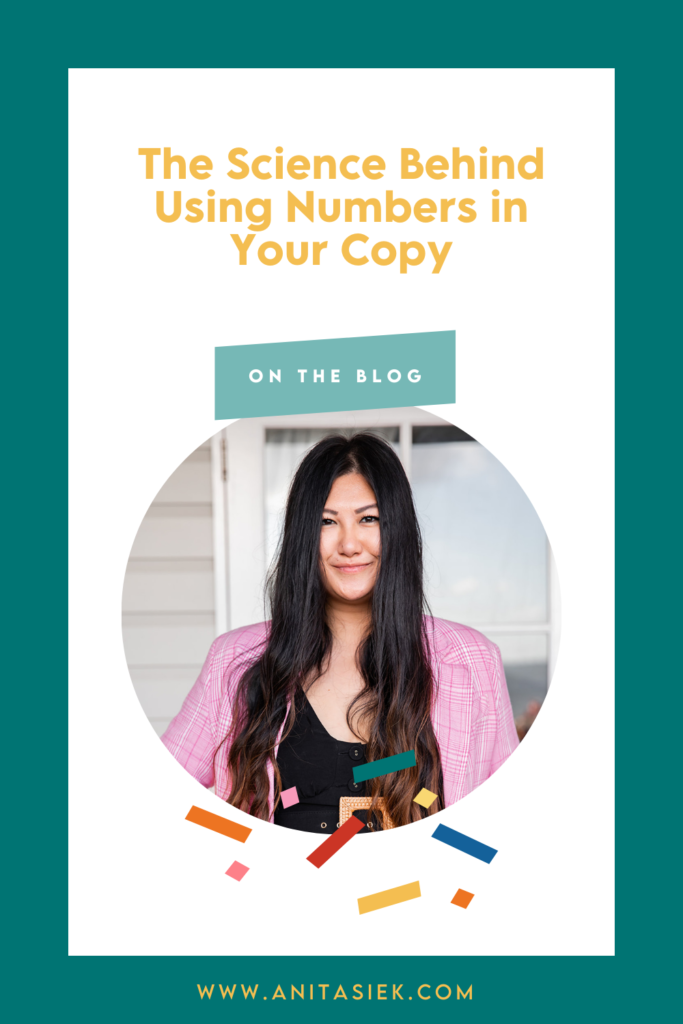The Anita Siek Blog
The Brandfetti Podcast
The Wordfetti
Shop
Podcast
Personal
Content Magic
Business
Lawyer (yep-a-dee-yep, I used to write things people never read) turned Brand and Copy Strategist, and Word-ucator for brands like you, who want to ZIG when others zag.
Hi, I'm Anita!
The Science Behind Using Numbers in Your Copy

Photo credit: @littledrill
Podcast Shownotes (Bullet)
- How you can make the numbers in your copy count backed by psychology and research.
- Three different types of studies have shown the use of numbers in our copy.
- 1st Study: Using actual numbers.
- 2nd Study: Concept of roundness.
- 3rd Study: Concept of reframing the price.
Podcast Shownotes (Timestamps)
01:29 – 01:40: How you can make the numbers in your copy count backed by psychology and research.
01:49 – 03:07: Three different types of studies have shown the use of numbers in our copy.
03:10 – 05:46: 1st Study: Using actual numbers.
05:49 – 08:22: 2nd Study: Concept of roundness.
08:23 -10:46: 3rd Study: Concept of reframing the price.

Ahhhhh, a copywriting word-wizard chatting about numbers?
Ironic on so many levels I could build a department store.
Allow me to explain.
Research has shown that the use of numbers in our copy, and sometimes changing a number, has the power to change the behaviour of your audience. Neat, huh?
Now, if you hear the word ‘numeral’ and start having horrid flashbacks to high school algebra (or
maybe that’s just me), don’t fret…
The type of numbers we are talking about are the cool kind (yeah there’s cool numbers), the kind psychology tells us will improve your content and have your readers wanting more.
There’ll be no “how many oranges does Jimmy have left if Sally is travelling on a train going 117km/h”type of numbers.
Let’s get straight to it:

#1 – Using actual numbers
First up. Let’s get straight to science. Our brains respond positively to organisation and categorisation. Numerals in your writing create those two things.
They help readers to skim, sort and grasp concepts with ease, making their life easier.
This totally pops you on their ‘words-we-love’ list – which obviously is right where you want to be. Numerals also add credibility, backing up the benefits you’re spruiking.
For example, use numbered lists to add order and create scannability (FYI we’re making that a word now). Readers can easily skim, as well as skip sections of content not relevant to them (we got you, skimmers!).
This was confirmed by a study done by Conductor, readers are 73% more likely to share and engage with a blog with numbers in the heading. For example…
13 reasons you should be reading this blog right now
The 17 untapped secrets of persuasive copy
27 ways to increase your conversion (and have fun doing it)
This is because humans like predictability.
They see credibility in the number and can grasp a sense of how long it’ll take them to read the article. They can also identify the value they’ll get out of the article quickly.
Bonus tip: Think outside the square. Even if your content isn’t a ‘listicle’, get creative and add numerals.
“Seeing Croatia in 7 days” will still cut through more with readers than “A week in Croatia”(and we’d totally have holiday #FOMO too). And rather than “you’ll save thousands each year”, make it specific and credible. “You’ll save $107 dollars each week – that’s $5564 yearly!”.
Leave ambiguity at the door.

#2 – Roundness
This is in relation particularly to price – our perception of numbers when it comes to the price of a product. Round prices are prices like $100 or $200. Whereas non-rounded prices are $98.76 or $198.97.
When it comes to our brain activity. The former is found to be processed fluently whereas the latter) disfluently.
So does one generate more sales?
According to a study by Wadhwa and Zhang (2015) – round prices — because they are fluently processed — work better for emotional purchases. For example, a house. Whereas non-rounded prices work more for rational purchases. Say, batteries.
Now. To add another layer to this, research from (Janiszewski & Uy, 2008) found that we as consumers assume that prices are artificially higher as if they were plucked from thin air, when they are rounded.
So with that, if you feel like your purchase is emotional, then LEAVE out the cents.
But if your purchase is based on rationality, then add cents.
When consumers can process the price quickly, the price “just feels right.”

#3 Reframe your Price
As consumers, we are deeply influenced by the context in which we see a price.
One concept found through research done by Gourville in 1998 is the idea of reframing your price into its daily equivalence. (e.g. $XX a day) so that people perceive it as a lower price. How many times have you seen an offering marketed as ‘just $1 a day’ or the cost of ‘a coffee each week’.
The regular price should always be the primary focus. But the low number will anchor people towards the lower end of the price spectrum. This has also been found to work by comparing the price to a petty cash expense, such as the aforementioned cup of coffee.
Want more incredible copywriting tips and hacks straight to your ears? Find me dropping wisdom on the Brandfetti podcast wherever you get your podcasts.
Want to get more copy, brand and content tips? Listen in on Brandfetti and follow me here and the team here.

Check out these popular posts


